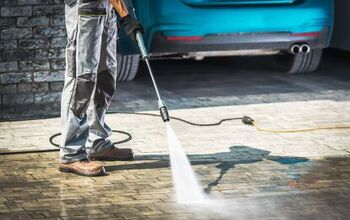Is It Illegal To Do A Burnout In Your Driveway? (Find Out Now!)

Whether you restore muscle cars in your garage or buy your dream sports car, burnouts are part of the thrill. The display of power is too much to resist. Burnouts on public streets are against the law, but is it illegal to do a burnout in your driveway?
Burnouts on private property are illegal in many jurisdictions. It is a matter of public safety and noise pollution, rather than property law. You may not get a ticket or go to jail, but it will cost you money. Burnouts damage your driveway, and repairs cost between $500 and $2,000. Burnout marks and a poor driveway also reduces property value.
Let’s take a closer look at burnouts and why a short-term demonstration of power may not be worthwhile.
Do You Need a Brick and Stone Floor Contractor?
Get free, zero-commitment quotes from pro contractors near you.

What is a Burnout?
A burnout is when you spin your tires while keeping the vehicle in the same spot. When the tires spin against a hard surface, such as concrete or asphalt, the rubber gets very hot. This creates a plume of smoke, and the rubber from the tires is deposited onto the hard surface. In some cases, the car may start to move sideways during a burnout.
Why are Burnouts Illegal?
Burnouts are illegal because the practice places public safety at risk. Spinning tires at a high speed and holding a car in one spot builds up a great deal of energy. If your foot slips off the brake pedal, all that energy pushes the car forward at a high velocity. Regaining control is difficult, at best. The car hits anything, or anyone, in front of it. You can injure yourself and others, and do a great deal of property damage.
Is It Illegal to Do Burnouts in Your Driveway?
In most jurisdictions, it is illegal to do a burnout in your own driveway, even if you live in a very rural area. It is a matter of public safety rather than property laws. Additionally, your neighbors have the right to complain about the noise, smoke, and smell of burning rubber.
Some cities, counties, and states consider burnouts to be violations of criminal laws. This means that you can be charged with a felony and go to jail.
Do Burnouts Do Damage?
Aside from the destruction to your tires, a burnout may damage your vehicle. Burnouts not only heat up the tires, but they also heat up the engine. Do a burnout for too long, and the engine overheats, or you may completely destroy your engine. The clutch and transmission can also overheat during a burnout.
There’s another factor to consider for how a burnout does damage – your driveway.
Does a Burnout Damage My Driveway?
Gravel, concrete, and asphalt are the most common materials that are used for residential driveways. You can attempt to do a burnout on gravel, but it only results in pelting your house, other vehicles, lawn, and neighbors with tiny projectiles. There is no spectacular display. Only a weekend spent filling in holes and replacing the gravel. But, what about harder surfaces, such as concrete and asphalt?
Burnouts on a Concrete Driveway
Concrete is a pretty durable material, and it may be able to withstand the heat and forces from a burnout. Unfortunately, all that rubber from your tires is now melted into the concrete, and you have a mess on your hands.
Burnouts on an Asphalt Driveway
Asphalt driveways soften under even a normal amount of heat and pressure. Now, consider how much excessive heat and pressure is being applied to this petroleum-based product during a burnout. As the asphalt heats up, your tires dig into the now warm asphalt. Do the burnout long enough, and your tires will eventually reach the gravel and soil under the driveway.
Asphalt is used for drag race strips, and the surface does make for a great show when you do a burnout. Your driveway, though, is not built to the specs of a drag strip. It simply can’t hold up to the forces of a burnout.
How to Get Burnout Marks Off a Concrete Driveway
You can remove burnout marks from concrete with a bit of work. Use a concrete degreaser or automatic brake cleaner. Apply the product to the tire marks, and let it sit for a few minutes. Use a stiff brush to scrub away the rubber.
How to Repair an Asphalt Driveway After a Burnout
Asphalt is more difficult to clean. The best way to remove burnout marks is to repair the surface. Remove any loose rocks and soil from around the hole. If you reached the soil with your burnout, add gravel to about 3” below the surface of the asphalt. Fill the rest of the hole with an asphalt patch compound.
Where Can I Legally Do a Burnout?
We’ve reviewed why you shouldn’t do burnouts on your driveway and how to repair the damage. Let’s now talk about where you can do burnouts. According to most jurisdictions, burnouts are only legal in a race setting. This means that the surface of the raceway is designed for burnouts, and there are safety plans in place, such as fences, run-off areas, and emergency medical personnel on site.
Contact law enforcement to find out where you can legally do burnouts in your area.
Related Questions
How do you remove oil stains from a driveway?
Mix powdered laundry detergent with water. Apply the paste to the oil stain, and scrub for 2 minutes with a stiff, nylon brush. Let the solution sit for 15 minutes, and rinse with water.
Is there a way to soundproof my yard?
Tall fences and trees block noise from neighbors. Water features help with noise. Install soundproofing materials along the fence.
Do You Need a Brick and Stone Floor Contractor?
Get free, zero-commitment quotes from pro contractors near you.

Summary
Burnouts on private property, including your own driveway, are illegal in most jurisdictions. You may be ticketed for reckless driving or disturbing the peace. In some places, burnouts are considered violations of criminal law, and you can be arrested on your own private property. Burnouts also damage your driveway, and you could spend $500 to $2,000 fixing the damage.

Jennifer L. Eggerton loves being hands-on, whether it's with a home DIY project, making repairs, re-decorating a room, or keeping life organized. She enjoys helping people by sharing her knowledge, insights, and experiences, as well as her lessons learned. In addition to her work as a writer, Jennifer is a Jeep® overlander, self-published author, and nature photographer who loves being outdoors.
More by Jennifer Eggerton























![12 Washing Machine Brands to Avoid [with Recall Data]](https://cdn-fastly.upgradedhome.com/media/2023/07/31/9075781/12-washing-machine-brands-to-avoid-with-recall-data.jpg?size=350x220)



